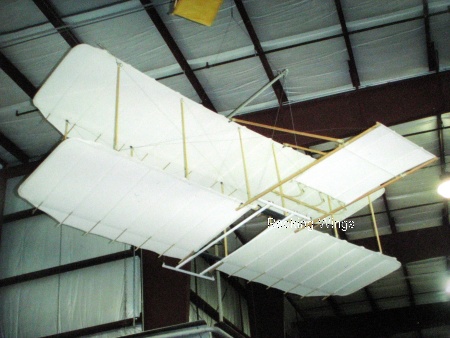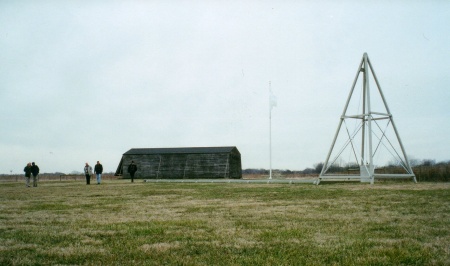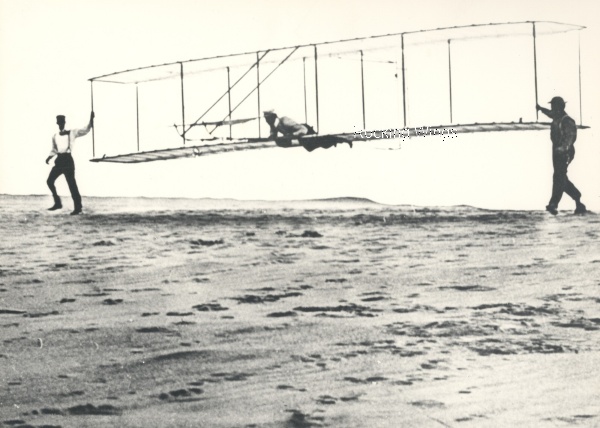It has often been suggested that Preston Watson built four aircraft in total, the first of which was described by J. D. Gillies and J. L. Wood in the book Aviation in Scotland as "...a primitive Wright-type glider, which was fitted with an engine of French manufacture but was not a success."
Reading of Watson's largely fictional achievements in a column that appeared in the 15 December 1953 issue of the Manchester Guardian newspaper that stated that Watson "...made a powered flight of between fifty and a hundred yards in 1903", aviation researcher Charles Gibbs-Smith drew conclusions to James Watson's claims in his book The aeroplane: an historical survey of its origins and development (HMSO, London 1960). Gibbs-Smith surmised that a possible first Watson aircraft would have probably resembled,
"...a primitive Wright-type aircraft with [a] forward elevator, built after Preston had heard of Octave Chanute's lectures and articles (in 1903) on his own and the Wright's gliders."

A reproduction of the Wright Brothers' 1900 glider at the Virginia Air and Space Museum. Is this what Watson's so-called "Wright Type" glider might have looked like? Eyewitnesses claim that it "...had an elevator out front" as illustrated here, although there is no mention of any other means of control in any of the statements about a Watson glider. Grant Newman
So, did Watson build a Wright type glider? Whilst investigating the Watson case, Gibbs-Smith met a close friend of the Watson family, former head of Kings College Dental Department, dental surgeon John Bell Milne, who claimed to have seen Preston's earliest flying machine. In an interview he gave in 1961, Milne remembered that Watson constructed his glider in a shed on the premises of his cousin Charlie Yeaman, of Yeaman and Baggesen, Marine Engineers of Dundee, stating that the date was, "...late 1903 or early 1904", at the time he and Preston, "...were attending physics classes at University College [Dundee]."
According to James Watson, the two brother's sister Effie sewed the fabric on to the wings, echoing British glider pioneer Percy Pilcher's sister Ella assisting him with the construction of his gliders. Despite his descriptions, Bell Milne emphatically stated to the anonymous reporter who interviewed him that he never actually witnessed Watson flying his biplane glider.
Many published sources accept James Watson's claim that Preston purchased an engine for his glider from renowned Brazilian aviator Alberto Santos-Dumont in 1906; the engine in particular being a Dutheil Chalmers opposed type. Despite John Bell Milne's personal assertion to Gibbs-Smith that the year the motor was purchased was indeed 1906, this was not possible, since Dutheil Chalmers & Cie did not build their first aero-engine until 1907.
Somewhat telling is that in an interview Bell Milne gave in 1961 he changed the date Watson purchased the engine from Santos Dumont to 1907! Photographs exist that show a Dutheil Chalmers motor fitted to Watson's first rocking wing aircraft, estimated to have been built in 1909, therefore it is likely that the supposed engine bought from Santos-Dumont was intended for this machine.
An account that appeared in the Vol. XLII No. 6 - June 1957 issue of Meccano Magazine stated that Watson fitted a small De Dion motorcycle engine to his glider, and that later two motors were coupled together. This would not have had the desired effect either, since no type of automobile engine available at the time would have had the correct power-to-weight ratio required to power an aeroplane in flight. From photographs of Watson's first aeroplane the unusual configuration of the Dutheil Chalmers engine can be seen; the propeller was mounted between two horizontally opposed banks of cylinders, resembling two different motors coupled together.
According to legend, fitted to Watson's newly acquired motor was a propeller constructed by a Mr Kerr B. Sturrock, who claims that he made over a dozen for Watson's aircraft in 1905. Some fifty years later Sturrock offered to James Watson recollections of assistance he gave to Preston, recorded in 1957 as the following;
"The first propellers were of oak or yellow pine. They were soon fractured, and then Mr Sturrock tried shaping them from laminated sheets of 5/8in. Australian walnut, each sheet being laid with its grain at a different angle from that of the one before it."
Fitted with its engine and propeller, James Watson asserted in the December 1955 Aeronautics magazine that, "this little aeroplane, though it stayed in flight sufficiently long enough to cover at least 200 yards, would not remain completely airborne..." "This was the year 1906."
Indulging in the argument, Charles Gibbs-Smith best places the claim that Preston bought a motor for his glider into perspective, stating that;
"...it was impossible to purchase up to 1905 or 1906 a petrol motor of a power-weight ratio anywhere near favourable enough to allow powered flight, to say nothing of the severe difficulties in designing and making an adequate propeller. Faced with this problem, the Wrights, after three years of intensive theoretical and practical research into aerodynamics and propellers, and the construction and operation of three gliders, designed and constructed their own engine in 1903."

A reproduction of the Wright's asisted take-off device they used to launch their aeroplanes with, on site at Huffman Prairie, outside of Dayton, Ohio, where they conducted flights in their 1904 and 1905 Flyers. It is rumoured that Preston Watson used such a device to get his first aircraft airborne, but substituting the framework for a tree from which the weights were suspended. Grant Newman
James Watson also stated that Preston's first aircraft took off with the aid of an assisted take-off device similar to that used by the Wrights for the first time at Huffman Prairie in September 1904. Charles Gibbs-Smith refutes the suggestion entirely that Preston conceived this kind of mechanism for launching his aircraft before the Wrights did, accusing James Watson and supporters who recalled seeing this device in action of "memory telescoping";
"it is inconceivable to me that a young man isolated in Scotland in that year 1903 - should have hit upon exactly the same method (except that he substituted a tree branch for the derrick from which the weight fell) as the Wrights devised in 1904."
Despite this however, in his book The aeroplane: an historical survey of its origins and development, Gibbs-Smith confirms his own presumption behind whether Watson built an aircraft in 1903 with the statement, "...my supposed powered Wright-type glider of Preston's..." That he describes it as a possible primitive Wright-type is merely a counter to James Watson's early assertions that the machine Preston built and flew in 1903 was a powered rocking wing type, the first of which he could not have begun constructing until early 1909 at the very earliest. Because of Gibbs-Smith's description, it is accepted without question by many that Watson's first aircraft was an unsophisticated Wright glider copy.
Exactly when Preston Watson carried out his first flights in this aircraft is the crux of the matter in the eyes of James Watson's supporters. For any claimant to powered flight earlier than the Wrights, the date of the Wright's first powered flight (17 December 1903) is when such flights must pre-date. It is therefore convenient for anyone recalling such an event some fifty years after it allegedly took place to quote the year as 1903 or earlier.
Even if 1903 was the date in which Preston Watson first flew a glider it was by no means unprecedented, even within the British Isles. The United Kingdom already had a glider pioneer of its own in the late Percy Sinclair Pilcher, who had built four gliders and had carried out many flights by the time of his accidental death in 1899. At that time Preston Watson was only 19 years old. With all the presumption surrounding Watson’s flying experiments; it is worth mentioning that Preston himself never made any mention of building any aircraft prior to his rocking wing machines.
Now, read about Preston Watson's first aeroplane here
